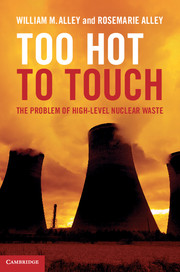Book contents
- Frontmatter
- Contents
- Acknowledgments
- List of units
- List of abbreviations
- Introduction
- Part I The problem
- 1 The awakening
- 2 Brainstorming
- 3 The ocean as a dumping ground
- 4 Radioactivity and atomic energy
- 5 The Cold War legacy
- 6 The peaceful atom and its wastes
- 7 Recycling
- 8 Dry cask storage
- 9 Interim storage
- 10 A can of worms
- 11 WIPP
- Part II The mountain
- Part III No solution in sight
- Appendix Discussion questions
- References
- Index
4 - Radioactivity and atomic energy
from Part I - The problem
Published online by Cambridge University Press: 05 February 2013
- Frontmatter
- Contents
- Acknowledgments
- List of units
- List of abbreviations
- Introduction
- Part I The problem
- 1 The awakening
- 2 Brainstorming
- 3 The ocean as a dumping ground
- 4 Radioactivity and atomic energy
- 5 The Cold War legacy
- 6 The peaceful atom and its wastes
- 7 Recycling
- 8 Dry cask storage
- 9 Interim storage
- 10 A can of worms
- 11 WIPP
- Part II The mountain
- Part III No solution in sight
- Appendix Discussion questions
- References
- Index
Summary
“The Italian navigator has just landed in the new world.”
“Is that so; Were the natives friendly?”
“Everyone landed safe and happy.”
Coded dialog between Arthur Compton and James Conant that Enrico Fermi's nuclear reactor had worked.In 1789, the German chemist Martin Heinrich Klaproth discovered that pitchblende, a black mineral with a dull, pitch-like luster from the mountains of central Europe, contained an unknown element. He named it uranium after the newly discovered planet Uranus, Greek for Titan of the Gods. The substance that Klaproth identified, however, was not pure uranium; it was uranium oxide. In 1841, Eugène M. Péligot, a French chemist, was the first to isolate elemental uranium.
The first known use of uranium dates to antiquity. When archaeologists excavated the Imperial Roman Villa near Naples, they found pale yellow–green glass from a first century AD mosaic mural. Roman artisans had used a uranium-bearing mineral to obtain the color. When Rome fell, the technique disappeared with it.
Eventually, people rediscovered that uranium produces lustrous hues of orange or yellow to glassware and ceramic glazes. Photographers used it to tone photographs. Outside of these trades, demand for uranium remained low. Uranium ore was considered mostly a worthless byproduct. Miners would toss it aside in their search for more valuable elements like steel-hardening vanadium. Then, at the end of the nineteenth century, a few major scientific discoveries changed everything.
- Type
- Chapter
- Information
- Too Hot to TouchThe Problem of High-Level Nuclear Waste, pp. 46 - 59Publisher: Cambridge University PressPrint publication year: 2012



